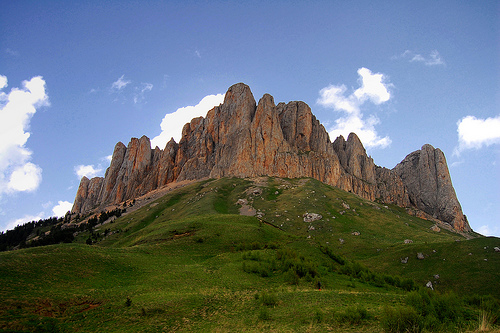
The Role of the Russian Orthodox Church in the North Caucasus
Publication: Eurasia Daily Monitor Volume: 6 Issue: 162
By:

On August 15 the Russian news agency ITAR-TASS reported that "unknown suspects desecrated the Orthodox holy cross in the mountains of Adygeya." The report came from Maikop the capital city of the Republic of Adygeya, located about 40 miles to the north of Sochi, the location for the 2014 Winter Olympics (www.vob.ru, August 20).
ITAR-TASS and numerous Russian outlets underlined that a religious reason was behind the act of vandalism. The article included a comment from the speaker of the Adygeya Orthodox Church Natalia Shevchenko, who said that the wooden cross, had been sawn off and thrown from Thkach, the highest mountain in Adygeya (The Mount of God in Circassian, 2,368 meters). The cross was installed in 2006 by members of the military group Russkiye Vityazi (Russian Knights), famous for their participation in the wars in Chechnya, South Ossetia and Abkhazia. The same crosses were also placed on the top of every high mountain throughout the Caucasus, as well as in Russian military bases. Shevchenko also noted that the same crime was committed in the village of Kammennomost in 2007.
According to the media, similar criminal acts have occured frequently in the North Caucasus. The most recent reports of such incidents came from Kabardino-Balkaria, Karachaevo-Cherkesia and Adygeya (www.spektr.info). The three regions were traditionally known as the "Circassian Belt," since the land historically belonged to the Circassians (Adygs, Abazas, Kabardins, Cherkess) who now constitute a significant element of the population in these republics. Although the majority of the Circassians, approximately 5 to 6 million live in exile in 56 countries, such statistics are only estimates since there has never been a case study on the Circassian diaspora.
Religious hatred is the first and the easiest explanation of these events, however the history of the relationship between the indigenous people and the Russian state and its representatives in the Caucasus is an important factor. Significantly, the potent combination of recriminations between Russians and Caucasians, which is rooted in a long history of warfare, has soured the atmosphere. However, for Moscow the main goal has never changed -to defeat, colonize, assimilate and control the populace, while the indigenous population focus on survival or liberation.
Among the numerous Orthodox churches scattered around the North Caucasus there are no reports of problems being experienced at the hands of their Muslim hosts. For instance, in Cherkessk, the capital of Karachaevo-Cherkessia, there are 18 churches in the city, but not one single mosque. However, holy crosses were thrown off the mountains of Karachaeva-Cherkessia, as in Adygeya last week (www.spektr.info).
In the view of the local people, these crosses do not represent religion: they are considered as memorials erected by murderers by those who killed and continue killing their sons, brothers, husbands, daughters, wives, sisters. The underlying reasons as to why local people attack Russian monuments are similar to the general background to Natalia Estemirova’s murder. She once refused to walk on the central street in Grozny, after the street was renamed by Kadyrov as Putin’s boulevard (www.guardian.co.uk, July 23).
Each of the representatives of the Russian Orthodox Church has a special duty – serving the Russian army in the conflict zones, blessing the new recruits before they go to war, and honoring those who died performing their duty (www.tver.eparhia.ru, December 13, 2001). Although there is nothing unusual in any of these activities, from a local perspective the Russian army and security services have waged war on civilians; while the Russian Orthodox has offered justification for these killings.
After the first war in Chechnya, public opinion in Russia was critical of the government’s action in the republic. Not only because of solidarity with the people of Chechnya, but also due to the loss of many young soldiers during the first war. Why did public opinion in Russia turn from strong protest to ignorance, and even approval on some levels? (www.specnaz.ru, December 7, 2005). Moreover, it appears that the Russian Orthodox Church has successfully fed this campaign by manipulating popular perceptions of the conflict. The crosses around the North Caucasus are symbolic of the union between the Church and the State in an effort to strengthen Velikaya Rus (Great Russia), regardless of the costs involved – be it the lives of thousands of civilians labeled as separatists, terrorists, religious extremists, or western spies, or Russian soldiers who die unknown and unreported, and in many cases even uncounted. Those deaths have been justified by the Russian Orthodox Church.




